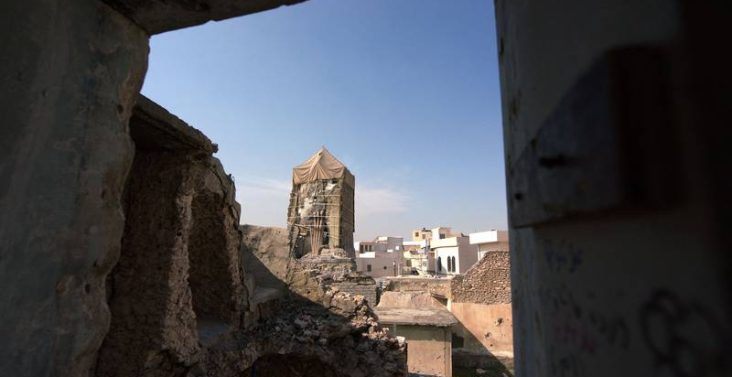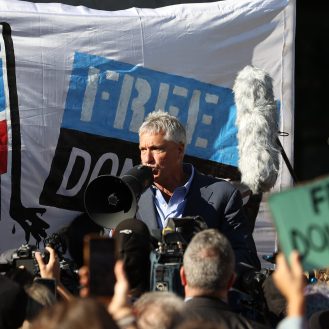In 2007, the seven states that rely on the Colorado River for water reached an agreement on a plan to minimize the water shortages plaguing the basin. Drought had gripped the region since 1999 and could soon threaten Lake Powell and Lake Mead, the largest reservoirs in the nation.
Now, that future has come to pass and the states are again attempting to reach an agreement. The Colorado River faces a crisis brought on by more than 20 years of drought, decades of overallocation and the increasing challenge of climate change, and Lake Mead and Lake Powell, its largest reservoirs, have fallen so low that their ability to provide water and generate electricity in the Southwest is at risk. But reaching consensus on how to avoid that is proving to be more challenging than last time.
“The magnitude of the problem is so much bigger this time, and it’s also so much more immediate,” said Elizabeth Koebele, an associate professor of political science at the University of Nevada, Reno.
Monday night, six states in the Colorado River Basin submitted a plan to the Bureau of Reclamation, the federal agency in charge of the damming and distribution of water in the West, laying out a potential way to protect the major reservoirs of Lake Powell and Lake Mead from reaching critically low levels, which could result in the loss of electricity for millions of Americans in the Southwest and largely block the river’s water from reaching Arizona, California and Nevada.
But California, the state that uses the greatest amount of water and has the strongest rights to the river, didn’t join the others that submitted the proposal to the federal agency. Instead, the state proposed its own plan with less drastic cuts. That means that for the second time in less than a year, the seven states that rely on Colorado River Water—Arizona, California, Colorado, Nevada, New Mexico, Utah and Wyoming—yet again failed to reach an agreement to cut back water usage.
“Unfortunately, despite numerous meetings and intensive good faith efforts, a seven-state consensus was not reached,” California wrote in its letter outlining its proposal.
In 2007, when the interim guidelines for shortages in the lower basin of the river were established, the Bureau of Reclamation pushed for the states to come up with a consensus agreement, Koebele said. They did that, which helped inform the guidelines. Without a consensus, she said, the current proposals don’t carry the same weight.
The issue then was seen as a short-term problem, said Kyle Roerink, executive director of the Great Basin Water Network, an organization focused on fresh water issues in Nevada and Utah. Now, he said, stakeholders realize the river has changed for the long run.
“Nobody wants to give up what they’ve got going for themselves in any part of the basin,” he said. “That’s why this is painful.”
The Jan. 31 deadline, however, was not for states to come up with a final solution on how to deal with the ongoing drought along the Colorado River and the need to drastically scale back the amount of water the states use. Rather, the timing was set by the states themselves to provide a model for the Bureau of Reclamation to evaluate as a potential alternative to either no action being taken, or the federal agency deciding itself how to cut back water usage along the river over the next three years.
“There’s a little bit more wiggle room than we initially thought” for coming up with an agreement, Koebele said.
In November, Reclamation announced it would conduct a supplemental environmental review of the 2007 interim guidelines with an eye toward confronting the low water levels of the reservoirs in the future. The supplement would modify the operations of the Glen Canyon and Hoover dams to avoid reaching water levels so low they could interrupt power generation or cease supplying downstream users in the coming years. The states have been asked to come up with a plan to cut between 2 and 4 million acre feet from the amount they are currently using.
“It is foreseeable that without appropriate responsive actions and under a continuation of recent hydrologic trends, major Colorado River reservoirs could continue to decline to ‘dead pool’—elevations at which water cannot be regularly released from a reservoir—in coming years,” the agency wrote last year.
Sarah Porter, director of the Kyl Center for Water Policy at Arizona State University, said Reclamation gave the states the ability to be the “masters of their destiny” if they could muster the political will to reach a consensus. “The federal government gave the states essentially an option of coming to an agreement of: ‘You’ll have more control of your destiny if you do it through agreement, but if you don’t, we’re going to take action because not taking action is going to be too consequential.’”
Both plans are just proposals for Reclamation and the public to review, Roerink said, and neither will become the law. Tribes, academics, nonprofits focused on the river and “anybody that has a stake in the game” will need to provide input as well, he said.
The Consensus-Based Modeling Alternative submitted by the six states upstream of California is not a formal agreement on what will be done, but a proposal to have the Bureau of Reclamation model what the six states have agreed to consider to reduce water usage while working towards a separate agreement on new operating guidelines that would be implemented in 2027.
The current proposals are part of a plan to modify interim guidelines that are set to expire at the end of 2026. Reclamation is also in the process of conducting another environmental review for how the river will be governed in the future.
The Colorado River Compact, signed in 1922, is the foundation for how water is allocated among the seven states, which it divides into two regions—the Upper Colorado Basin, consisting of Colorado, New Mexico, Utah and Wyoming, where most of the water in the river originates, and the Lower Colorado Basin, made up of Arizona, California and Nevada, which have historically used more of the river’s flow. Under the compact, each region received 7.5 million acre-feet a year of what was assumed would be more than 16 million acre feet a year in the river. In reality, the river flowed with closer to 13.5 million acre feet a year, and in recent decades that amount has declined.
“Whatever we do in the short term will inform what we do in the long term,” Porter said. “So much of this is about whether or not the Colorado River can continue to supply as much water as it currently does to agriculture” because the bulk of the water goes to that sector.
The proposal submitted by the six states largely calls on further cuts for states in the Lower Basin to account for over 1.5 million acre feet of water lost due to evaporation and system losses, and takes further steps to protect Lake Powell and Lake Mead, such as increasing the cuts to water releases at the reservoirs’ current elevation levels, resulting in around 2 million acre feet of reductions.
At the current levels of Lake Mead, the six-state proposal calls for immediate deep cuts to the Lower Basin. California’s proposed cuts would be more modest—and the deepest reductions wouldn’t begin to match what the other states propose until the water level falls to some of the lowest shortage tiers.
Where the two plans differ, Roerink said, is that California’s plan would impose more cuts on the Upper Basin and calls for any further reduction to follow the law. That means less reduction of the supply to California due to its holding the strongest rights, and more to Arizona, which agreed to have junior water rights in 1968 in return for forming the Central Arizona Project, a 336-mile long system that delivers Colorado River water to around 80 percent of the state’s population.
“California doesn’t have to do anything under the current law,” Roerink said.
Keep Environmental Journalism Alive
ICN provides award-winning climate coverage free of charge and advertising. We rely on donations from readers like you to keep going.
Rebecca Mitchell, the Colorado Commissioner of the Upper Colorado River Commission, said in an emailed statement that the “Upper Division States regularly use less than half of our Compact apportionment and significantly less than the Lower Division States, who have been able to rely on reservoir storage in times of low flows.”
Nonetheless, Colorado and the other Upper Basin states remain committed to working with all parties, she wrote. While the proposal represents progress towards finding a solution, she wrote that “all basin states recognize that our work is not done” and that “this modeling approach simply provides a mechanism for the Bureau of Reclamation to begin analyzing options available to it to protect critical infrastructure at Lake Powell and Lake Mead.”
Tyler Cherry, a spokesperson with the Department of the Interior, which includes the Bureau of Reclamation, wrote in an emailed statement that the “ongoing conversations with the Basin states, Tribes, water managers, farmers, irrigators and other stakeholders are helping to inform the supplemental process to revise the current interim operating guidelines for the operation of Glen Canyon and Hoover Dams.”
“This will help ensure that any action from the Department is done with as much support and consensus as possible,” he wrote.
Koebele said the main controversy around the proposed Consensus-Based Modeling Alternative is that Lower Basin states have to cut back to offset water losses to evaporation from the entirety of the river and its reservoirs.
“The states really reached some disagreement with California, who would be responsible for taking the cuts that are associated with that evaporation and California argues that we should just account for it and reduce the total water supply, which doesn’t hurt them when they have the highest priority of the river,” she said.
Legally, priority for allocation of the Colorado River is given to users that were first to establish their rights to the water. California has the strongest water rights among the seven states that depend on the river. Last year, to address shortages at Lake Mead, Arizona, Nevada and Mexico were forced to take cuts to their supplies for 2023. But, thanks to its strong water rights, California was able to avoid them.
Porter, at Arizona State University, said the next few months will involve more discussions aimed at creating a consensus among all seven states. Reclamation expects to have the environmental review complete by this spring and a final decision by late summer. The models the Colorado Basin states and other entities submit will help guide that decision, but Reclamation will have the final say.
However, no agreement will be litigation-proof, Porter said.
“It wouldn’t be a huge surprise if a very senior water rights user sued if their water supplies were cut” by the federal government, Porter said.









